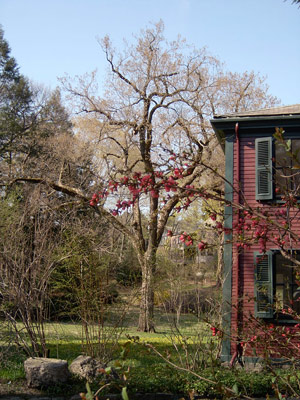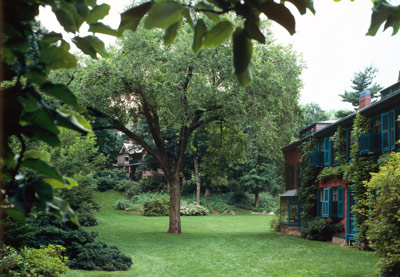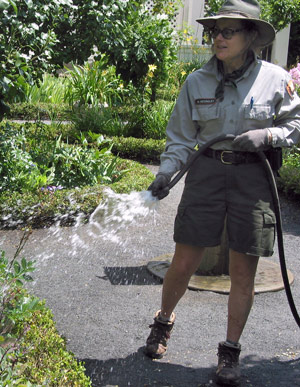Profile in Preservation
QUICK FACTS
Position: Gardener
NPS Start Date: 1989
Gardener Position Start Date: 1991
Specializations: Preservation maintenance, restoration planting, rejuvenative pruning
Associated Landscapes:
- Frederick Law Olmsted National Historic Site
- Longfellow House - Washington's Headquarters National Historic Site
- John Fitzgerald Kennedy National Historic Site
MEET MONA McKINDLEY
Mona McKindley is a gardener at three national historic sites in the Boston metropolitan area: Frederick Law Olmsted National Historic Site, Longfellow House - Washington’s Headquarters National Historic Site, and John Fitzgerald Kennedy National Historic Site. Mona is responsible for the day-to-day care of all three former residential landscapes, two of which were designed by famous designers and pioneers in the American landscape architecture profession. Mona’s knowledge and passion for horticulture and history guide her stewardship of these three important, yet distinct landscapes.
Mona began her National Park Service career as a seasonal interpretive ranger at Mesa Verde National Park in Colorado. Her academic background in geography and anthropology prepared her for interpreting the cultural resources at this southwestern park. She subsequently worked at San Antonio Missions National Historical Park in Texas and Rock Creek Park in Washington, D.C. before transitioning to the field of landscape maintenance.

NPS
Over the past twenty-two years, Mona has refined her skills as a National Park Service gardener, working side by side with experienced professionals. In her spare time, she studies horticulture, landscape history, and landscape design. During winter 2012–13, Mona completed a Master of Liberal Arts in Extension Studies at Harvard University, with acceptance of her thesis, “With a Heart of Oak: John Quincy Adams, Scientific Farmer and Landscape Gardener.” Her combined professional experience in landscape maintenance and personal interests make her an exceptionally adept cultural landscape steward.
Preservation gardening best describes a large portion of Mona's work. Working on the grounds of historic properties, Mona possesses an exceptional knowledge of the design trends, gardening techniques, and materials used during the historic periods represented by the three parks. Mona has a particular specialization in sourcing historic plant varieties and in identifying appropriate substitutes if historic varieties are not available. However, she is not only experienced working with historic vegetation; as the parks' integrated pest management coordinator, Mona is also responsible for addressing contemporary pests and diseases that affect all vegetation.

NPS
Being a gardener at historic sites does not mean that Mona uses antique tools, but rather that her work is carried out with the goal of perpetuating historic character. She uses modern landscape maintenance equipment, but often relies on traditional gardening techniques. For example, Mona uses manual garden shears to prune and shape boxwood hedges in the Longfellow House formal garden because sharp shears make cleaner cuts than electric hedge trimmers, provide greater control, and allow hedges to recover from pruning faster. Mona believes that visitors should see the landscapes freshly weeded, trimmed, and raked, just as they would have been during their respective historic periods.
Mona attests that the best part of her position, however, is interacting with others. Teamwork is essential to successful cultural landscape stewardship, and Mona regularly collaborates with horticulturists, arborists, nurserymen, historical landscape architects, and archaeologists on major restoration projects. Her current work involves mentoring summer youth interns and collaborating with volunteers and members of local chapters of the Garden Club of America. Her eagerness to learn from everyone and her passion for sharing her extensive knowledge with others makes her a model steward.
Landscape Sketches

NPS
Frederick Law Olmsted Sr. (1822–1903) is hailed as the father of American landscape architecture. Best known for his work in Central Park, Olmsted’s designs reflect his belief that parks represent the democratic ideals of community and equality. “Fairsted” served as the home and studio of Olmsted Sr. and his sons, John Charles Olmsted and Frederick Law Olmsted Jr., who also were practicing landscape architects. As the first full-scale professional landscape architecture office in the nation, Faristed was also the workplace of other of influential designers; among them were James Frederick Dawson, Charles Eliot, Percival Gallagher, Henry Vincent Hubbard, and Edward Clark Whiting.
Today, the Fairsted landscape is maintained as it appeared at the height of the firm’s operation. The grounds demonstrate the Olmsteds’ commitment to the Picturesque design aesthetic and their skill in integrating functionality and beauty in the landscape. The landscape is full of hidden surprises, from rock outcroppings, to plants with bold fall foliage and dramatic bark, to old-fashioned shrubs, groundcovers, and wildflowers. The maintenance team uses techniques developed at the park to maintain the wild and rustic character of landscape. Park grounds are open to the public year-round.

NPS
Longfellow House - Washington's Headquarters National Historic Site preserves the home of Henry W. Longfellow, one of the world’s foremost nineteenth century poets. The house also served as headquarters for General George Washington during the Siege of Boston, from July 1775 to April 1776. In addition to its rich history, the park offers unique opportunities to explore nineteenth century literature and arts.
A major landscape feature is the formal garden, which was updated in the early twentieth century by two women pioneers of landscape architecture, Martha Brookes Hutcheson and Ellen Biddle Shipman. The National Park Service restored Alice Longfellow’s lush and densely planted, old-fashioned cut-flower garden between 2002 and 2006. The park grounds are open to the public year-round.
John Fitzgerald Kennedy National Historic Site
Brookline, MA

NPS
John Fitzgerald Kennedy National Historic Site preserves the birthplace of America's 35th president. After his assassination in 1963, the president's mother, Rose Fitzgerald Kennedy, collaborated with the National Park Service to restore the house interior to its 1917 appearance, and to create a commemorative landscape setting along the London plane tree-lined street.
The landscape, only one-tenth of an acre, will undergo rehabilitation as recommended in the 2012 Cultural Landscape Report. This rehabilitation will include replacement of select vegetation and site furnishings, as well as collaborative efforts with the Town of Brookline to preserve the character of the larger Coolidge Corner neighborhood where Kennedy spent his formative years.
MORE ON MONA
Other Experience:
- Adams National Historical Park (Massachusetts)
- Bureau of Land Management (California)
- Fa'asao High School (American Samoa)
- Mesa Verde National Park (Colorado)
- President's Park (The White House)
- U.S. Soldier's and Airmen's Home (Lincoln Cottage)
- National Mall, Washington Monument, Vietnam Veterans Memorial, and Rock Creek Park (District of Columbia)
- San Antonio Missions National Historical Park (Texas)

NPS
Plant Health Tip:
Do not take your soil for granted. Dig around and loosen it up. Test to see if it is too acidic or alkaline. Amend as needed before the growing season begins. In the spring, weed, rake, aerate, and amend the soil in garden beds if necessary, before adding mulch.
Landscape Design Tip:
Gather photos of plants you like in a scrapbook. When you are ready to plant, do not just buy what looks good at the nursery, buy what you need for a particular spot in your garden.
Favorite Plants:
Trees: Redwood and Kauri (of New Zealand)
Houseplant: Orange flowering clivia
Last updated: November 7, 2016
